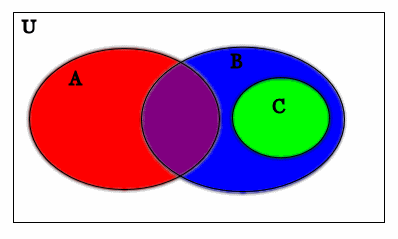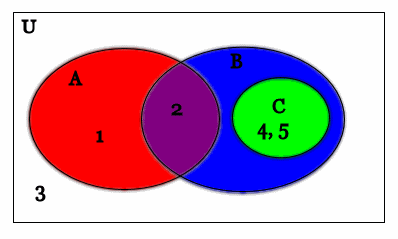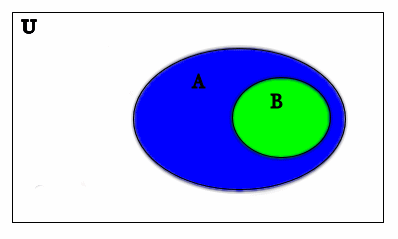

Sometimes a set is completely empty. Some examples of empty sets are:
{x| x is a whole number between 1 and 2}
There is no whole number between 1 and 2, so this set is completely empty.
{x| x is a solution to the equation x2+1=0 and x is a real number}
There is no real number that we can put in for x that will make x2+1=0, so this set is completely empty.
Notice that these sets are well-defined; we can always tell whether or not something is actually in the set (the definition of what is in the set is completely clear), it's just that nothing is actually in these sets.
When a set is completely empty, we call it the NULL SET or the EMPTY SET and we use the symbol Ø to represent it. We can also represent the empty set like this: {}. Be careful not to confuse Ø with 0. Zero is a number, but Ø is not a number; it is a set that contains NO numbers (or anything else, for that matter). Also be careful not to confuse Ø with {Ø}. Ø is the set {}; it doesn’t contain anything, whereas {Ø} is a set that contains another set as an element: the null set or empty set.
A set can contain other sets as its elements. For example:
{{5, 28}} This is a set containing one other set: {5,28}.
{{1},{4}} This is a set containing two other sets: {1} and {4}.
{{1,2,3,4},{2,4,5},{2,5}} This is a set containing 3 other sets: {1,2,3,4}, {2,4,5}, and {2,5}.
{Ø} This is a set containing one other set: the null set.
{Ø, N, Z, R} This is a set containing four other sets: Ø, N, Z, R.
{{Ø},{Ø, N, Z, R}} This is a set containing two other sets: {Ø} and {Ø, N, Z, R}.
Be careful not to confuse the set {5,28} with the set {{5,28}}. {5,28} is the set containing two elements: the two numbers 5 and 28. In contrast, {{5,28}} is the set with one element: the set {5,28}. And neither of these two sets are the same as the set {{{5,28}}}. This set is the set containing one element, the set: {{5,28}}, which we’ve already determined is not the same as the set {5,28}. Likewise, the set {{1},{4}} is different from the set {1,4}. Both sets contain 2 elements, but {{1},{4}} contains two sets and {1,4} contains two numbers.
Often we want to count the number of elements in a set. We call the number of distinct elements in a set the CARDINAL NUMBER or CARDINALITY of the set. I can write n(A)=26 to say “the number of distinct elements in the set A is 26”. So, for example:
If B={-3, 1.99999, π}, then n(B)=3, because the cardinality of B is 3 or, in other words, the set B contains 3 distinct elements.
If C={1,2,3,…,2000} then n(C)=2000 because the cardinality of C is 2000 or, in other words, the set C contains 2000 distinct elements.
Be careful here! A lot of students want to say that n(C)=4 because only four elements are listed when we write the set C: 1,2,3, and 2000. But remember, this set contains all the elements between 3 and 2000, too! So it doesn’t just have 4 elements!
If D={δ, β, β, γ, λ, β} then n(D)=4 because the cardinality of C is 4 or, in other words, the set C contains only 4 distinct elements. At first glance it may look like the set actually contains 6 elements, but notice that the 6 things which appear in the set are not distinct elements! Three of these things are just the same element repeated 3 ties; the element β appears 3 times in the set, but we only want to count it once.
Be careful when writing about the cardinality of sets to include the lowercase n and the parentheses! For example, if A={2,4,5,8,10} then the cardinality of A is 5. But we must write n(A)=5; we CANNOT write A=5, because this is not true - A is not the number 5, but a set which contains 5 elements! Even though 5 is an element of A, we still cannot write A=5; for that we would have to write 5∈A instead!
Whenever we are working with sets, we always have to specify what larger set we are working in; for the purposes of a given problem, what "universe" are we working in? This larger set is called the UNIVERSAL set.
Before we can do anything with sets, we have to be very clear about what “world” we are working in.
If our universal set is the set of all integers, then any sets we look at in that problem will contain only integers.
If our universal set is the set {2,4,6,8,10,12.5}, then any set in this “world” cannot have any elements that are not 2,4,6,8,10, or 12.5. For example, a set containing the number 9, or the letter r, or the word "supper" would not be permitted, because it cannot fit within the universal set.
Every set we talk about within a particular “world” is a subset of the UNIVERSAL set.
We usually represent the UNIVERSAL set with the letter U.

To make it easier to talk about sets, we often draw pictures that describe the relationships between sets. The pictures consist of a rectangle which represents the boundaries of the UNIVERSAL set, and circles or ovals which represent the sets within the universal set at which we are interested in looking. For example, let the universal set be the set U={1,2,3,4,5}, and let’s consider the sets A={1,2} B={2,4,5} and C={4,5}. The Venn diagram describing these sets would look like this:

In this diagram, the set A is represented by the red oval, the set B is represented by a blue oval, and the set C is represented by a yellow oval; the universal set is represented by a white rectangle. But when we put these sets together in the picture, anywhere that the shading overlaps, the colors combine to make a new color. So the purple area in the middle of the drawing is where the sets A and B overlap. The set C looks green, because when we put a yellow oval on top of a blue one, the colors mix to produce green. The white area outside the sets represents those elements that are in the universal set, but not in sets A, B, or C, but the colored areas represent where the sets A, B, and C overlap with the universal set; the universal set includes everything in the rectangle, whether it is white or a different color.
Here is the diagram again, but with the every element of the universal set labeled:

In this Venn diagram, 1 is in the set A, but not in the set B or the set C, so it is in the red region; this is the part of the set A which does not overlap with sets B or C. The 2 is in the set A and also the set B at the same time, but it is not in the set C, so it is in the purple region where the red A oval and the blue B oval overlap. The numbers 4 and 5 are in the set B and the set C at the same time, so they are in the green area where the yellow C oval and the blue B oval overlap. The number 3 is not in the sets A, B, or C, but is in the universal set U, so it is in the white area outside the colored sets A, B, and C. All the numbers 1,2,3,4,5 are within the rectangle because they are in the universal set. The number 6, for example, would not be on our diagram, because it is not in the universal set. If we wanted to write it in, we'd have to put it outside the rectangle which encloses the diagram.
We will be using Venn diagrams a lot in the next section to visualize the relationships between sets.
The main benefit of Venn diagrams is that we can use them to depict sets, even if we don't know anything about what those sets contain. So if we want to prove that a general rule is true for any set, or for any two sets, etc, we do this by drawing a Venn diagram.

If you think about some of the sets we already know, you may notice that there seems to be a relationship between certain sets. For example, the set of all counting numbers is almost the same as the set of all whole numbers, except that it lacks the number 0 as an element. And all the elements of the set of whole numbers are also elements of the set of integers. We want a way to talk about these relationships between sets more formally, so we'll introduce some definitions that allow us to do that.
We call a set A a SUBSET of another set B if every element of A is also an element of B. We write A⊆B to indicate that A is a subset of B. If we want to say that A is not a subset of B, instead we write A⊄B. For example:
A={1} and B={1,2,3} Here A⊆B because 1 is the only element of A and 1∈B.
C={1,2,3} and D={1,2,3} Here C⊆D because all the elements of C are 1,2, and 3, and 1∈D, 2∈D, and 3∈D.
B={1,2} and A={2,3} Here B⊄A because 1∈B but 1∉A.
Be careful not to confuse A⊆B with B⊆A! A⊆B means that all the elements of A are also in B, whereas B⊆A means that all the elements of B are also in A. So you might have A⊆B but B⊄A, or you might have B⊆A but A⊄B, but you will only have A⊆B and B⊆A if A and B are exactly the same set.
N⊆Z⊆Q⊆R because all natural numbers are integers, all integers are rational numbers, and all rational numbers are real numbers. In other words, if a number is a natural number, then it must also be in the set of all integers (because the set of integers contains all positive and negative whole numbers by definition); if a number is an integer, it must also be in the set of all rational numbers (because any integer over 1 is a fraction); if a number is a rational number, it must be in the set of real numbers (because any number which can be written as a fraction can also be written as a decimal by performing long division and dividing the numerator by the denominator).
B⊆B for ANY set B. Because, obviously, any element that is in B will also be in B! Notice that we don't have to know anything about what is in the set B or what the set B looks like to come to this conclusion - it is true no matter what is in B !
Ø⊆A for ANY set A. This one is a little tricky. Let's explore this for a minute to see if we can understand why we can say that all elements of Ø are also elements of A when Ø has no elements:
This is an interesting point about mathematics. If assuming that something is false leads us to a contradiction, we conclude that that something must be true. We often say that a statement like this is “true by default.”
Notice that we don't have to know anything about what is in the set A or what the set A looks like to come to this conclusion - it is true no matter what is in A!
We call a set A a PROPER SUBSET of a set B if A is a subset of B and A≠B. To indicate that A is a proper subset of B we write A⊂B. A proper subset is just a special kind of subset.
Notice that the ONLY difference between a subset and a proper subset is that A⊆B means that A and B CAN be equal, while A⊂B means that A and be CANNOT be equal; but both A⊆B and A⊂B means that "every element of A is also an element of B" .
For example:
A={1} and B={1,2,3} Here A⊂B AND A⊆B because 1 is the only element of A, and 1∈B, but A≠B.
B={1,2,3} and C={1,2,3} Here B⊄C BUT B⊆C because B=C.
C={1,2,3} and D={2,3,4} Here C⊄D AND C⊄D because 1∈C but 1∉D.
Notice that if A is a proper subset of B, then it is always also a subset of B. Note also that if A is not a subset of B, then it cannot be a proper subset of B either. But A can be a subset of B and still not be a proper subset of B; whenever A and B are exactly the same set, they are subsets of one another, but they are not proper subsets of one another.
We can also use Venn diagrams to draw a visual picture of what it looks like when one set is a subset of another. For any two sets, A and B, if B is a subset of A, we have the following Venn diagram, where the set A is represented by a blue oval and the set B is represented by a yellow oval, and where any place that the yellow and blue overlap looks green:
B⊆A

Because B is contained entirely in A, we depict it by drawing it completely inside A. All the elements of B are also elements of A, so anything that would appear in the yellow oval is also inside the blue oval. In this diagram, the part of the blue oval which remains blue depicts the elements of A which are not in B. The green oval, where the yellow B oval and the blue from the oval representing A have blended, represents any elements which are in the set B, which, because B is a subset of A, will also be inside the blue oval representing the set A. The white area outside the ovals represents any elements which are not in the sets A or B, but which are in the universal set (however, remember that any elements in sets A and/or B are also in the universal set).
Now that we have defined subsets, we can actually rewrite our definition of the EQUALITY of two sets:
We say a set A is EQUAL to a set B if every element of A is in B and every element of B is in A. In other words, A=B if and only if A⊆B AND B⊆A. So, for example:
{1,2,3}={1,2,3}because {1,2,3}⊆{1,2,3} and{1,2,3}⊆{1,2,3}.
{1,2,3}≠{2,3} because {2,3}⊆{1,2,3}BUT {1,2,3}⊄{2,3}
Sometimes we want to list all of the possible subsets of a set.
Let’s try this for the set A={6,7}:
Ø⊆A These are all the subsets of A that contain 0 elements. (Remember that the null set is a subset of ANYTHING!)
{6}⊆A, {7}⊆A These are all the subsets of A that contain 1 element.
{6,7}⊆A These are all the subsets of A that contain 2 elements. (Remember that a set is always a subset of itself!)
So the set {6,7} has 4 subsets, but only 3 proper subsets. (Because {6,7} is a subset but not a PROPER subset, because it is equal to A .)
Let’s try this for the set B={1,2,3}:
Ø⊆B These are all the subsets of B that contain 0 elements. (Remember that the null set is a subset of ANYTHING!)
{1}⊆B, {2}⊆B, {3}⊆B These are all the subsets of B that contain only 1 element.
{1,2}⊆B, {2,3}⊆B, {1,2}⊆B These are all the subsets of B that contain 2 elements.
{1,2,3}⊆B These are all the subsets of B that contain 4 elements. (Remember that a set is always a subset of itself!)
So the set {1,2,3} has 8 subsets, but only 7 proper subsets. (Because {1,2,3} is a subset of B, but not a PROPER subset of B, because it is equal to B .)
As you count the number of possible subsets of each set, you may begin to notice a pattern:
A set with no elements (the null set) has only 1 subset (itself) and 0 proper subsets.
A set with 1 element has 2 subsets (the null set and itself) but only 1 proper subset (the null set).
A set with 2 elements has 4 subsets, but only 3 proper subsets.
A set with 3 elements has 8 subsets, but only 7 proper subsets.
A set with 4 elements has 16 subsets, but only 15 proper subsets.
Do you see the pattern?
Every time we add another element to a set, it doubles the number of subsets!
Notice that the actual elements in the set do not affect how many subsets a set has; only the number of elements in the set, or the cardinality of the set determines the number of subsets which a set will have!